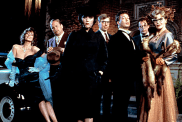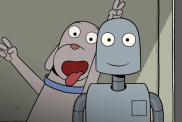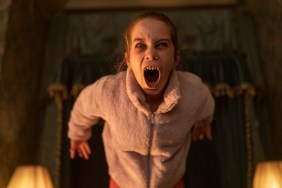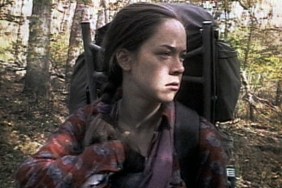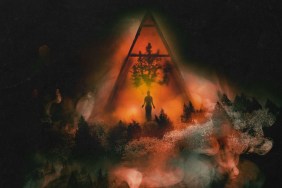Cast:
Nicolas Cage as Behmen
Ron Perlman as Felson
Stephen Campbell Moore as Debelzaq
Stephen Graham as Hagamar
Ulrich Thomsen as Eckhart
Claire Foy as The Girl
Robert Sheehan as Kay
Christopher Lee as Cardinal D’Ambroise
Kevin Rees as Dying Monk
Andrew Hefler as Jail Bailiff
Fernanda Dorogi as Old Woman (Givaudon)
Rebekah Kennedy as Peasant Turk Girl
Matt Devere as Sergeant in Arms
Róbert Bánlaki as Livery Boy
Barna Illyés as Cardinal’s Priest
Kevin Killebrew as Demon (voice)
Directed by Dominic Sena
Story:
In the 14th Century, two knights who have been fighting in the Crusades (Nicolas Cage, Ron Perlman) abandon their post out of frustration with the innocents being killed in the name of God. In order to prevent themselves from being tried as deserters, they agree to escort a young girl (Claire Foy), accused by the church of being a witch responsible for a terrible plague that’s hit the land, to a distant abbey to be tried for her crimes.
Analysis:
Better filmmakers than Dominic Cena have tried and failed to set movies in the Middle Ages and during the time of the Crusades, but taking more of a genre approach by creating a supernatural thriller set during the time of witches and the plague may make one want to give the movie’s historical accuracy a bit more leeway. It would be fine if the audience was not supposed to be taking anything in “Season of the Witch” too seriously, if only the cast and filmmakers didn’t subscribe to that same adage.
One would think an opening involving the hanging of a trio of “witches” would set the tone for the film, but we then meet the knights Behmen and Felson whose care-free banter during battle gives us some idea of the grizzled veterans’ mindset when they decide to abandon their mission and return home. Things have gone downhill in the two years since that opening sequence with plague spreading across the land, and the duo are soon off on a journey to escort a “witch” locked in a large caged wagon to her trial, along with a motley group including a priest with ulterior motives (Stephen Campbell Moore), a sleazy merchant (Stephen Graham) and an altar boy looking to become a knight himself (Robert Sheehan).
While those interested in European history might be intrigued by the setting, what kills the movie from ever achieving even a level of mediocrity is the bland and uninspired writing that feels so inauthentic not only to the times but also to how anyone speaks. It doesn’t really give the actors much to work with, so it’s hard not to feel as if Nicolas Cage is phoning this performance in, since there’s neither the passion nor the energy you’d expect from a movie in which so much stuff is happening around them. Then there’s the accents which are all over the map as perfectly fine British and Irish actors try to alter their own accents to sound more American, possibly to spare Cage the indignity of not being able to remotely pass off a British accent. He tries it for a couple of lines and then eventually gives up.
Ron Perlman is definitely the best part of the movie, having some of the snappiest one-liners and retorts to his long-time compatriot, though forced to match Cage’s lack of energy, even his funniest lines are delivered with very little life. Even so, the movie is best when the duo are on-screen together, though as soon as other characters are introduced, it feels like the screen time is spread out among them in order to try to make the supporting characters more three-dimensional. The rest of the cast are generally decent enough, but it also creates a deathly lull once they hit the road and much of the second act involves them each talking about their respective pasts, their connections to the journey, etc.
When the group approaches a worn-out rope bridge, that’s when any semblance of credibility goes out the window as we’re led to believe a group of men can push a fairly heavy wheeled caged wagon across a bunch of rotten wooden boards strung across a chasm, which immediately collapses behind them after achieving the impossible. The film’s inability to maintain continuity are fairly blatant. Shortly after having his hand spiked through the center with his own crucifix, the priest is among a group of men holding a rope that’s slowly letting this wagon going across the bridge. This is a guy who probably isn’t used to manual labor who only has the use of one hand, so why are they even allowing him to do something so strenuous that requires two hands? A short while later, the group are attacked by wolves that look real enough in some scenes, then for whatever reason, they’re altered by cheesy CG to make them look more menacing – it doesn’t work. In one shot, it even looks like Cage is wrestling with a stuffed animal.
There’s something about the entire film that feels cheap, like they didn’t have quite the budget to achieve the scope and scale required to make things work, including the opening battle montage. The CG work is generally amateurish at best with fire that looks fake and CG creatures that look worse than some of the YouTube animation done by high school students. This is the most evident in the film’s climax when the group finally arrives at the abbey and they have to face a bunch of monks possessed by demons and one of the most ridiculous looking CG creatures we’ve seen since “Van Helsing.” Being a movie essentially produced within the studio system with a more than adequate post-production schedule, it’s fairly inexcusable.
After such a terrible and ineffective climax, the film ends with a rather dismal epilogue with a lazy voiceover about how everything has changed and that those whom sacrificed themselves on the journey would be remembered. The movie on the other hand will easily be forgotten.
The Bottom Line:
“Season of the Witch” isn’t horrible–it’s not even close to Nicolas Cage’s worst movie–but it’s lacking any sort of energy and the relatively weak premise at its core means there’s very little anyone or anything could have been done to salvage it.

